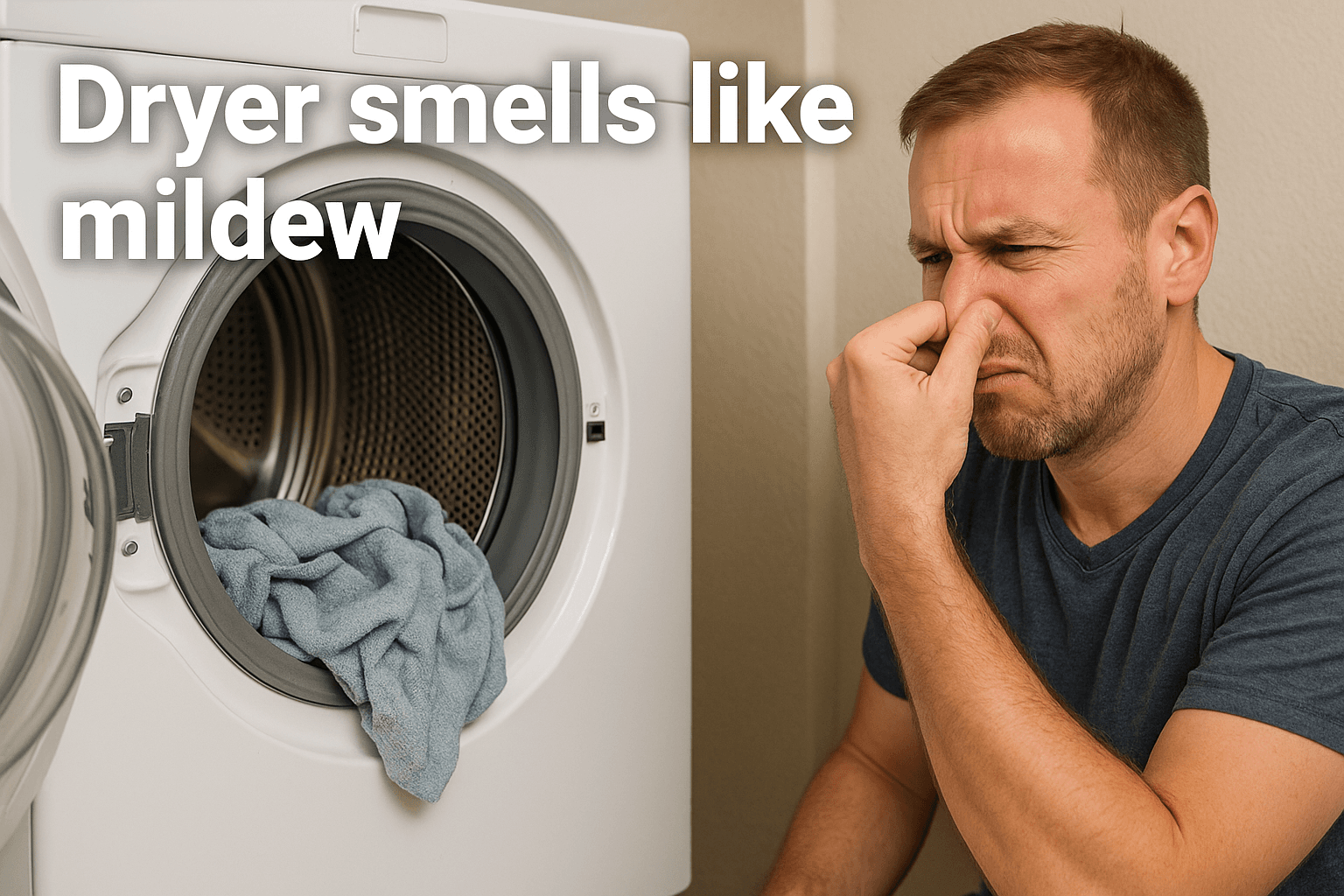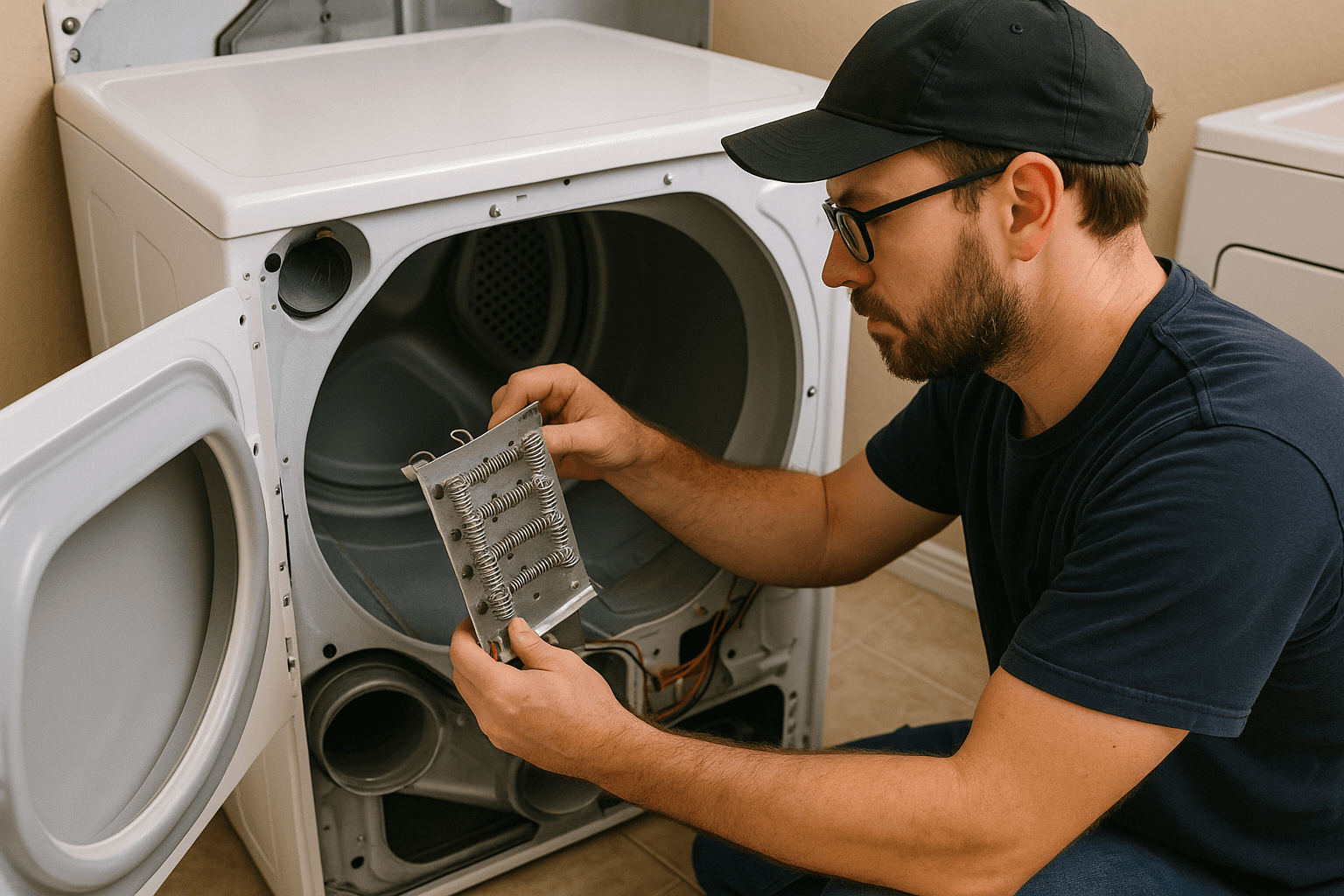Repair help
Why Dryer Smells Like Mildew? How to Clean
AZparts Team
Updated on November 28, 2025
6 min read
Does your dryer smell like mildew every time you open the door? That musty odor is a common sign of moisture buildup and poor ventilation, often caused by clogged lint traps, dirty vents, or worn-out parts. While regular cleaning is essential, truly eliminating the dryer issue may require replacing faulty components such as lint screens, door seals, or vent hoses. In this article, AZParts explore the common causes behind why your dryer smells like mildew and provide practical tips to eliminate those unpleasant odors.

1. Why Does Your Dryer Smell Like Mildew?
Here are the most common causes behind that unpleasant mildew smell in your dryer:
- Wet clothes left in the dryer for too long: Letting damp laundry sit in the drum without starting the cycle encourages mold and mildew growth.
- Built-up moisture due to poor ventilation: Inadequate airflow prevents the dryer from fully expelling moisture, creating a damp environment.
- Clogged lint trap: A lint trap full of residue or lint can trap moisture and reduce airflow, making your dryer a breeding ground for mildew.
- Moldy lint inside the vent or drum: Lint and dust buildup in hidden areas can become moldy if exposed to ongoing humidity.
- Detergent or fabric softener residue: Over time, leftover product buildup can mix with heat and moisture, creating a musty smell.
- Failure to clean the lint screen and vent system regularly: Lack of routine maintenance allows moisture and mold to accumulate inside the system.
If your dryer smells like mildew, it's often due to trapped moisture, leftover lint, or wet clothes left inside for too long. Regular cleaning, proper ventilation, and starting the dryer promptly after loading can prevent the musty odor and help your appliance stay fresh and efficient.
Wet clothes left for too long causes dryer smells like mildew (Source: AZParts)
2. How to Eliminate Bad Odors from Your Dryer
A lingering bad smell in your dryer can transfer to clean clothes and make laundry day frustrating. Whether you’re dealing with a mildew odor, burnt smell, or just general mustiness, the key is a deep and thorough cleaning. Follow this step-by-step process to remove bad odors from your dryer and keep it fresh and hygienic.
2.1. What You’ll Need
To thoroughly clean and maintain your dryer and reduce the risk of mildew odors, prepare the following:
- White vinegar (natural deodorizer)
- Warm water
- Mild dish soap
- Clean microfiber cloths or sponges
- Soft brush or old toothbrush
- Vacuum cleaner with hose attachment
- Replacement parts if needed (e.g., lint screen, dryer vent, door seal/gasket, drum belt)
- Screwdriver set (for inspecting or replacing parts)
2.2. Step-by-Step Guide to Cleaning Your Dryer Inside and Out
Follow this detailed process not only to clean your dryer but also to inspect and replace worn parts that often cause trapped moisture and musty smells.
2.2.1. Step 1. Clean the lint screen
Remove the lint screen and remove all visible lint by hand. Then wash it with warm soapy water to remove detergent residue that can trap moisture. Dry it thoroughly before placing it back. If your lint screen is damaged, torn, or clogged beyond cleaning, replace it immediately, a faulty lint screen greatly increases the risk of mildew buildup and bad dryer smells.
Clean the lint screen is the first step to clean dryer (Source: AZParts)
2.2.2. Step 2: Vacuum the lint trap
Use a vacuum with a hose attachment to clean out the lint trap and reach deep into the dryer vent. Lint buildup in the vent not only reduces drying efficiency but also traps moisture, creating an ideal environment for mold. If you notice your vent hose is cracked, crushed, or kinked, replace it with a new one to ensure proper airflow and prevent moisture retention.
Read more: How to Clean a Dryer Vent Properly
2.2.3. Step 3: Mix cleaning solution
Prepare a cleaning solution of equal parts white vinegar and warm water with a few drops of mild dish soap. This natural mixture kills mold spores and neutralizes odors without harsh chemicals that might damage your dryer’s interior.
Mix white vinegar and warm water to clean dryer to avoid mildew (Source: AZParts)
2.2.4. Step 4. Wipe down the dryer drum and door
Carefully examine the drum and the rubber door seal (gasket). The door seal can often trap moisture and lint, becoming a hidden source of mildew smell. Use the cleaning solution with a soft cloth or toothbrush to scrub these areas thoroughly. If you find cracks, tears, or excessive mold on the door seal, replace it to prevent odors and maintain an airtight dryer drum.
Wipe down the dryer drum and door (Source: AZParts)
2.2.5. Step 5. Rinse and dry again
Wipe the drum and door seal with a clean, damp cloth to remove any cleaning residue. Follow up by drying all surfaces with a dry microfiber cloth. Leaving moisture inside can restart mold growth, defeating your cleaning efforts.
2.2.6. Step 6. Deodorize with white vinegar
Place several towels lightly dampened with white vinegar into the dryer. Run a high-heat cycle for 10 to 15 minutes to deodorize and kill remaining mold spores. This natural deodorizing method is a safe alternative to chemical sprays.
3. Tips to Prevent Moldy Dryer Smell
Keeping your dryer fresh not only ensures clean-smelling clothes but also helps maintain the appliance’s performance. Here are a few simple tips to prevent moldy dryer smell and stop unpleasant odors from developing inside your machine, especially helpful if your dryer smells like mildew.
- Don’t leave wet clothes sitting in the dryer: Always start the drying cycle immediately after loading wet laundry. Sitting damp clothes create a perfect environment for mold and mildew.
- Clean the lint screen after every use: Removing lint prevents moisture retention and improves airflow, which reduces odor risks. Replace the lint screen if it’s damaged or clogged to maintain proper function.
- Regularly vacuum the lint trap and vent: Built-up lint in the vent system traps moisture and causes musty smells. Schedule deep cleaning every few months. Replace worn or cracked dryer vent hoses to ensure proper ventilation.
- Wipe down the drum and door seal monthly: Moisture and detergent residues can accumulate on the drum and door gasket. Use a vinegar-water solution to clean and disinfect these areas. Replace the door gasket if it shows signs of damage or mold buildup.
- Ensure proper dryer ventilation: Check for kinks or blockages in your dryer vent hose. Damaged vents restrict airflow and trap moisture, increasing odor risks.
- Replace worn dryer parts as needed: Components like lint screens, door switch, vent hoses, drum felt seal, drum rollers, and moisture sensors wear out over time and can contribute to odors. Using quality replacement parts from trusted suppliers, such as AZParts, can help keep your dryer fresh and efficient.
- Run a vinegar towel cycle occasionally: Toss in a few towels lightly dampened with white vinegar and run a high-heat cycle to naturally neutralize odors and kill mold spores, a simple way to prevent moldy dryer smell from returning.
Tips to Prevent Dryer Smell like Milder (Source: AZParts)
By combining regular cleaning with timely part replacements and good dryer habits, you can prevent bad odors and extend the life of your appliance.
Maintaining a fresh-smelling dryer requires a combination of regular cleaning and timely replacement of worn parts. By addressing moisture buildup and ensuring proper ventilation, you can prevent mildew odors from developing. Buying quality dryer parts from trusted suppliers like AZParts not only helps eliminate bad smells but also extends the life and efficiency of your dryer. Take these steps today to keep your dryer routine clean and odor-free.
Contact Information:
- 8 The Green, Ste A, Dover, Delaware 19901-3618, United States
- support@azparts.com
Your dryer may encounter other errors:
Dryer
Further Reading
Further Reading





